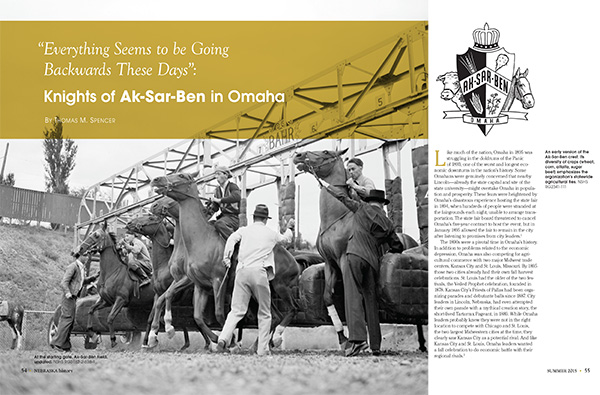 Like much of the nation, Omaha in 1895 was struggling in the doldrums of the Panic of 1893, one of the worst and longest economic downturns in the nation’s history. Some Omahans were genuinely concerned that nearby Lincoln—already the state capital and site of the state university—might overtake Omaha in population and prosperity. These fears were heightened by Omaha’s disastrous experience hosting the state fair in 1894, when hundreds of people were stranded at the fairgrounds each night, unable to arrange transportation. The state fair board threatened to cancel Omaha’s five-year contract to host the event, but in January 1895 allowed the fair to remain in the city after listening to promises from city leaders.
Like much of the nation, Omaha in 1895 was struggling in the doldrums of the Panic of 1893, one of the worst and longest economic downturns in the nation’s history. Some Omahans were genuinely concerned that nearby Lincoln—already the state capital and site of the state university—might overtake Omaha in population and prosperity. These fears were heightened by Omaha’s disastrous experience hosting the state fair in 1894, when hundreds of people were stranded at the fairgrounds each night, unable to arrange transportation. The state fair board threatened to cancel Omaha’s five-year contract to host the event, but in January 1895 allowed the fair to remain in the city after listening to promises from city leaders.
The 1890s were a pivotal time in Omaha’s history. In addition to problems related to the economic depression, Omaha was also competing for agricultural commerce with two major Midwest trade centers, Kansas City and St. Louis, Missouri. By 1895 those two cities already had their own fall harvest celebrations. St. Louis had the older of the two festivals, the Veiled Prophet celebration, founded in 1878. Kansas City’s Priests of Pallas had been organizing parades and debutante balls since 1887. City leaders in Lincoln, Nebraska, had even attempted their own parade with a mythical creation story, the short-lived Tartarrax Pageant, in 1889. While Omaha leaders probably knew they were not in the right location to compete with Chicago and St. Louis, the two largest Midwestern cities at the time, they clearly saw Kansas City as a potential rival. And like Kansas City and St. Louis, Omaha leaders wanted a fall celebration to do economic battle with their regional rivals.
The celebrations in St. Louis, Kansas City, and Omaha were all originally designed to boost attendance at fairs in their respective cities. Fall was a crucial time for the mercantile elite. Omaha merchants, for example, wished to draw farmers to sell their crops to them rather than to merchants in Kansas City or Des Moines. While often cloaked in philanthropic or altruistic language, these celebrations were viewed by city leaders primarily as a way to increase the profits of the mercantile elite and other businessmen who would benefit from the influx of tens of thousands of tourists.
In response to the state fair board, in 1895 Omaha’s Commercial Club committed resources for an adequate transportation system and for improving buildings for the fair. They even built a “White City” at the fairgrounds, evoking the memory of the World’s Columbian Exposition in Chicago two years earlier. In March 1895 the Commercial Club’s executive committee proposed that Omaha create its own Mardi Gras-style celebration. A few weeks later, like their counterparts in St. Louis nearly twenty years earlier, several of these men went to New Orleans to secure floats and parade costumes from one of the Mardi Gras Carnival Societies. (Contemporary newspaper accounts do not specify which Krewe sold the Omaha businessmen the floats.) The committee arranged for these floats to be shipped to Omaha via a special fifteen-car train. Thus the celebration was literally a second-hand Mardi Gras.
Many newspaper accounts and histories of Ak-Sar-Ben erroneously claim that its members visited the pageants of the Veiled Prophet and the Priests of Pallas on their train ride back to Omaha in April 1895. In fact, both celebrations took place in October, but it’s possible that on the return trip the Omaha men visited their counterparts in St. Louis and Kansas City, and from them learned the basics of putting on such spectacles, and began to ponder their use of mythology.
As the story goes, it was on the train ride back from Kansas City that the men came up with the name of their organization. Dudley Smith observed, “Why not reverse the name of our beloved state, since everything seems to be going backwards these days? Nebraska hyphenated and spelled backwards is Ak-Sar-Ben.” They consulted with a Catholic priest on the train, Father Enright of Kansas City, who told them that “Ak” was the word for “head of household” in Syrian, “Sar” was the word for “household” in Arabic, and “Ben” was the word for “brother” in Hebrew. Thus, Enright contended that the whole word stood for the King, his Domain, and his Retainers. Enright and the Omaha men also decided that the proposed “domain of Ak-Sar-Ben” be known as the Kingdom of Quivira, named after the mythical golden kingdom that Coronado had sought in the Great Plains in 1541. And thus was created the Knights of Ak-Sar-Ben, which still exists to this day. With these preliminaries out of the way, the new organization began to prepare in earnest for their celebration.
The entire essay appears in the Summer 2015 issue.



